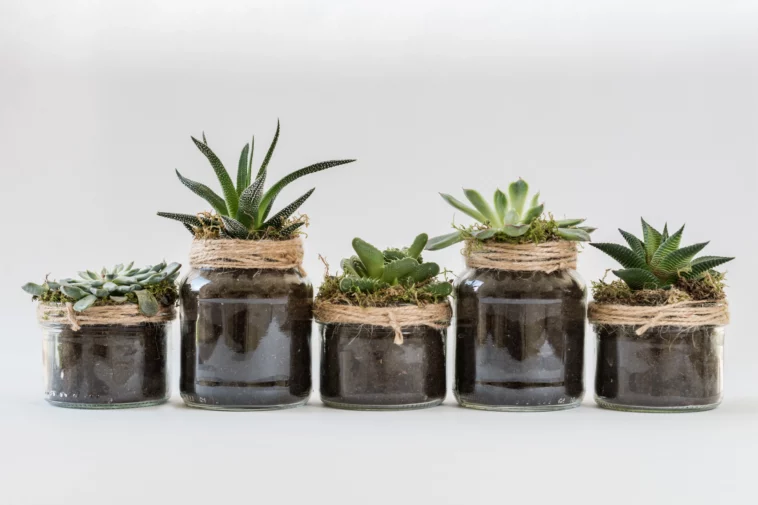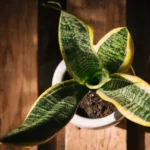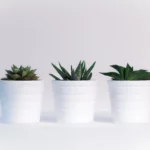Do you want to know how to repot your succulent plant? Being unsure about how to repot is common among new plant parents. It can seem daunting to move your plant to a new home. But we’re here to help.
Here is our guide on how to get it right!
Repotting a succulent should be done when either the roots have become rootbound, there is something not quite right about the current pot, or just because you want to.
The new pot should be 1 size bigger than the previous one (if the plant has become rootbound), contain the proper drainage facilities, and use suitable soil.
To repot a succulent, you will need to carefully remove it from the old pot, remove the soil from the roots, fill a new pot with new soil, add the plant, and fill up the rest of the pot.
Table of Contents
Reasons why you should repot your succulent
Current pot is too small
The first reason why you may wish to repot your succulent is that it has grown so much that it has now outgrown the pot it lives in. This is kind of like how you need to get new clothes as you keep growing larger.
When plants grow to a certain size in a pot that’s too small, you may no longer find enough nutrients within the soil to maintain it. For your plant to continue growing, they will need to be moved into a bigger pot, which will have more soil with more nutrients to absorb.
Something is wrong
Another reason why you may wish to repot your succulent is that something is not quite right. This may be because you’ve received the plant from a previous owner or because you’re new to plants and have just realised a mistake.
Several factors could be off about your succulent’s pot. For example, the soil could be oversaturated, the wrong kind of soil, or in a pot that doesn’t have adequate drainage holes.
Repotting a houseplant may also be an attempt to combat diseases such as “root rot”.
Because you want to
Or maybe there isn’t anything wrong with your succulent’s current pot. You only wish to repot it for aesthetic reasons, for example, if someone has given you a plant pot as a present. You wish to have it on display when the giver visits. Or perhaps you want to move it into a pot that better fits with the “aesthetic” of the rest of a room.
It would look a bit off if you have a room filled with old oak but with a metallic plant pot in there.
One of the primary purposes of house plants is that they look nice, and if you think it’ll look nicer in a different pot, we say, go for it.
When to repot a succulent
Your plant has several ways of saying to you, “I’d like to go into a different pot please”. When it has become rootbound, meaning the roots now occupy most of the pot, that is a sign the pot needs to be upsized.
Issues such as dry leaves, yellow leaves, or mushy stems are signals of root rot and usually mean your plant will need to be repotted.
When it’s time to repot your plant, we have some advice on what you need to be aware of.
Criteria for your succulents new pot
The right size
If you’re upsizing a succulent’s pot because the previous one is too small, it’s helpful to know what size you should be aiming for. When a succulent is in a pot that’s too small, excess water will have nowhere to flow to and will stagnate around the roots, increasing the chances of root rot.
However, should the pot be too big, the roots will be sitting in wet soil, which can have a similar impact that a small pot has.
When you upsize your plant pot, make sure to only go one size up. One size means two inches. So when a plant outgrows its 10-inch pot, it should be moved to a 12-inch pot.
The right drainage
Drainage is also an essential part of a snake plants pot. Snake plants can easily be overwatered. They will need to have somewhere they can expel the water, which it is unable to absorb. The best way to do this is by making sure it’s kept in a pot with a drainage hole at the bottom.
However, if this is not possible, add some rocks to the bottom of the pot. The stones will create a channel for the unwanted water to flow into.
The Right Soil
Different plants require different types of soil. Most of us are familiar with those memes where dandelions are presented as tough plants, able to thrive in concrete. In contrast, houseplants are wimps that need a specific pH to survive.
But in reality, if dandelions are so tough, how come most of them would die if you were to put them in an environment ideal for succulents?
While some plants are more adaptable to different soil types than others, you will need to know what kind of soil is best for it when you have a houseplant.
Cactus Soil
Succulents and cactuses often live in pretty similar environments- warm places where water is generally relatively scarce. For this reason, most soils that are designed for cactuses would also be excellent for succulents.
This kind of soil tends to be well-draining and can accommodate the long roots that succulents and cactuses often have. It also contains the right variety of nutrients for succulents and in the proper concentrations too.
In fact, some brands of cactus soil market themselves as “cactus and succulent soil”.
Sand and Soil Mix
Although maybe you’re in a situation where cactus soil isn’t an option. Or perhaps you just don’t want to spend more money than you already do on soil.
In this case, the perfect kind of soil for a succulent would be a 1:1 mix of regular potting soil and sand. You can make this by measuring half a pot of potting soil and half a pot of sand and mixing it together.
Much like cactus soil, this mixture will also allow excess water to easily drain away from the roots. It will also provide your plant with the necessary nutrients.
How to repot a succulent
- The first step is to remove your succulent from its old pot. Make sure to do this slowly, as you don’t want to damage it. It may be helpful to wear gloves if you have a sharp variety of succulent.
- If the reason for repotting was the quality of the soil, you would need to remove the old soil for your plant. The best way to do this is by hand. However, you need to do it gently so as to not damage the roots.
- At the bottom of your new pot, add your soil mix (either cactus soil or 50:50 sand: soil). The amount you add will depend on the size of your pot in relation to the soil. Aim to have the entirety of the roots covered in soil. Usually, this will mean filling the pot to ¼-¾ of the way.
- On top of the first load of soil, add your plant, making sure to hold it in place, so it doesn’t fall over. And then follow up by filling the pot with the rest of the soil. After this step, all of the roots should be underground, but the stem and leaves should still be above ground.
- At this stage, whether or not you water will depend on why you repotted it. If it was to combat root rot, don’t. If it was for another reason, do.
Useful information on repotting succulents
Is pot sharing acceptable?
Some people like to have large pots with several different kinds of plants within them. This can work with succulents. In fact, in the wild, succulents will have to share their soil with various other plants.
However, if you choose to have plants sharing a pot, you need to make sure that each pot only contains plants that require the same kind of soil.
A succulent sharing a big pot with other succulents or cactuses is fine. But a succulent sharing a pot with roses is unlikely to be successful.
Creative ways of repotting
Just because something isn’t marketed as a “plant pot”, that is not to say it can’t be used as one. Items such as woven baskets, old food containers, wooden crates, or ornamental bowls can be transferred into plant pots with a few moderations (such as the addition of drainage holes)
Websites such as Pinterest, Instagram, and small blogs can give you ideas on creative ways to make a plant pot.
Conclusion
And there we have your guide on how to repot a succulent. Succulents are one of the best plants for new plant parents as they require little watering and are easily adaptable to new environments.
Learning how to repot a plant is a part of being a plant parent. It’s one thing we all need to learn how to do.
Hopefully, now you have a better idea of knowing when your succulent wishes to be repotted and how to do it. Compared to some other plants, succulents are actually some of the easiest to repot.
Photo by Ylanite Koppens from Pexels


